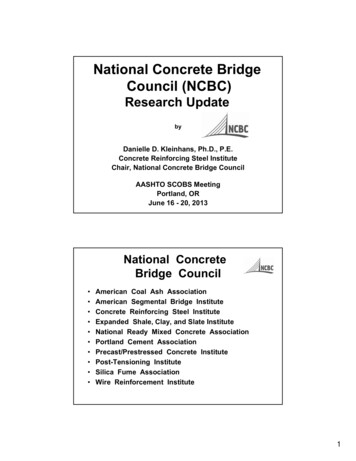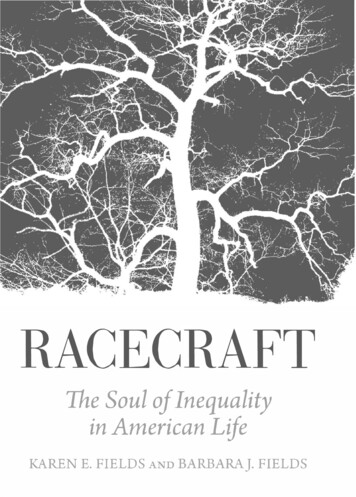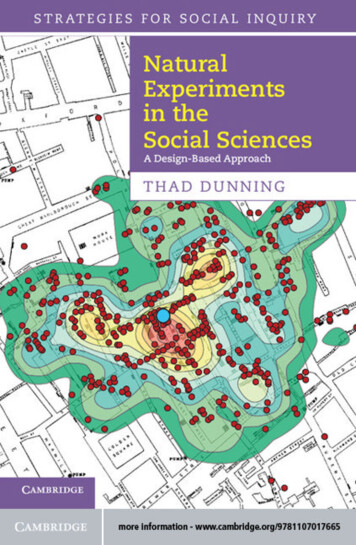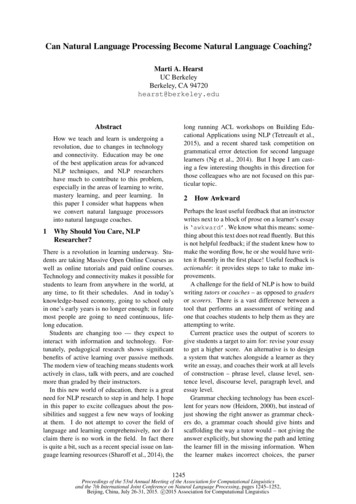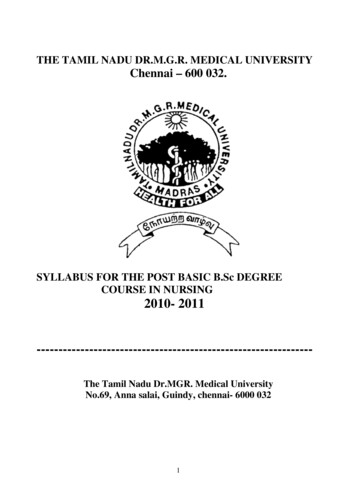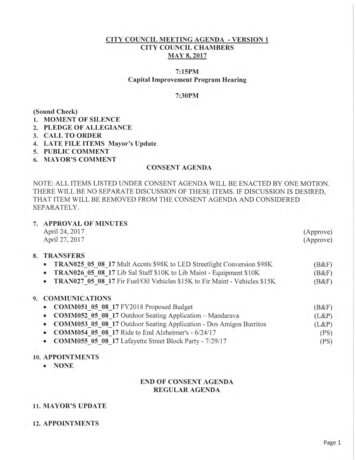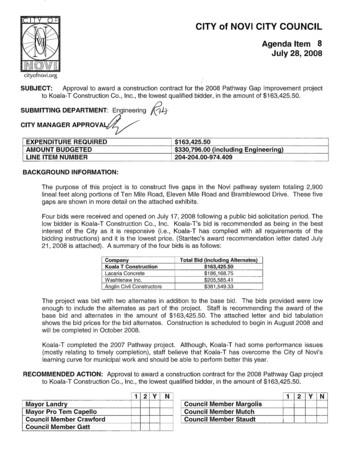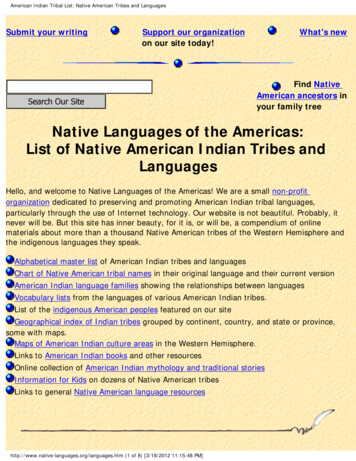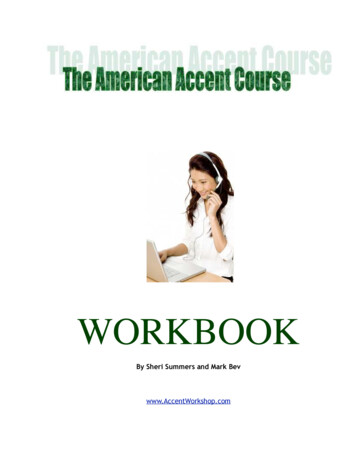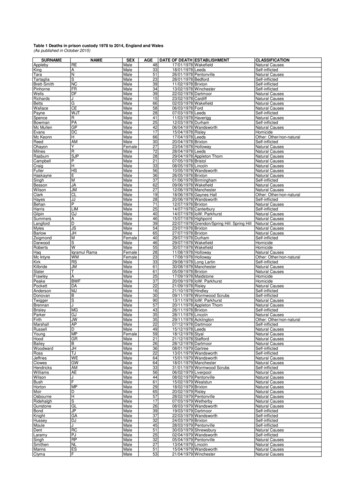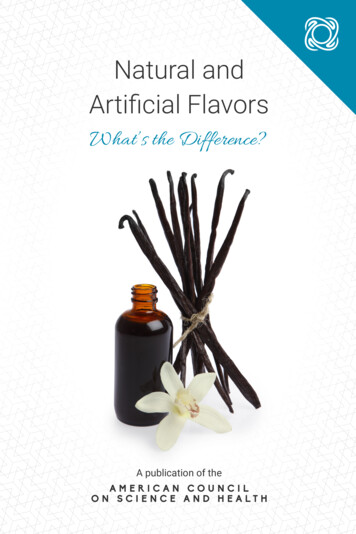
Transcription
Natural andArtificial FlavorsWhat’s the Difference?A publication of the
Natural and Artificial FlavorsWhat’s the Difference?Written byJosh Bloom, Ph.D.A publication of the
Natural and Artificial Flavors: What’s the Difference?Copyright 2017 by American Council on Science and Health. Allrights reserved. No part of this book may be used or reproducedin any matter whatsoever without written permission except in thecase of brief quotations embodied in critical articles and reviews.For more information, contact:American Council on Science and Health110 East 42nd St, Suite 1300New York, NY 10017-8532Tel. (212) 362-7044 Fax (212) 362-4919URL: http://www.acsh.org Email: acsh@acsh.orgPublisher Name: American Council on Science and HealthTitle: Natural and Artificial Flavors: What’s the Difference?Author: Josh Bloom, Ph.D.Subject (general): Science and HealthPublication Year: 2017Binding Type (i.e. perfect (soft) or hardcover): PerfectISBN: 978-0-9910055-9-8
AcknowledgementsThe American Council on Science and Health appreciates thecontributions of the reviewers named below:Rhona Applebaum, Ph.D.Executive (retired)Food AssociationNew York, NYMartin Di Grandi, Ph.D.Associate Professor of ChemistryDepartment of Natural SciencesFordham College at Lincoln CenterJoe Schwarcz, Ph.D.Professor of ChemistryMcGill University, MontrealMichael D. Shaw, Ph.D.Executive Vice PresidentInterscan CorporationReston, VAChristoph W. ZapfAssociate Director, Medicinal ChemistryNurix, Inc.San Francisco, CA
American Council on Science and HealthTable of Contents1. Introduction - - - - - - - - - - - - - - - - - - - - - - - - - - - - - - - - - - - - - - - - - - -62. A chemical is a chemical, no matter its origin- - - - - - - - - - - - - - - - - -83. The fundamental difference between natural and artificial flavors-114. Vanilla- - - - - - - - - - - - - - - - - - - - - - - - - - - - - - - - - - - - - - - - - - - - - - -13Flavor- - - - - - - - - - - - - - - - - - - - - - - - - - - - - - - - - - - - - - - - - - - - - - - - - - - - - -13Safety considerations- - - - - - - - - - - - - - - - - - - - - - - - - - - - - - - - - - - - - - - - - -145. Grapes - - - - - - - - - - - - - - - - - - - - - - - - - - - - - - - - - - - - - - - - - - - - - - -17Flavor- - - - - - - - - - - - - - - - - - - - - - - - - - - - - - - - - - - - - - - - - - - - - - - - - - - - - -17Safety considerations- - - - - - - - - - - - - - - - - - - - - - - - - - - - - - - - - - - - - - - - - -186. Bananas- - - - - - - - - - - - - - - - - - - - - - - - - - - - - - - - - - - - - - - - - - - - - -237. Exploitation of consumers by the “natural fallacy”- - - - - - - - - - - - - -298. Summary - - - - - - - - - - - - - - - - - - - - - - - - - - - - - - - - - - - - - - - - - - - - -31References - - - - - - - - - - - - - - - - - - - - - - - - - - - - - - - - - - - - - - - - - -335
American Council on Science and Health1IntroductionOf the many misconceptions used in the “natural vs. artificial” narrative,two stand out: (1) That artificial flavors are inherently less healthy thantheir natural counterparts, and (2) that a flavor chemical obtained from anatural source is either different or superior to the same flavor chemicalproduced in a laboratory or factory.Together, these beliefs represent a cornerstone of the naturalmovement. As pervasive as this mindset is among consumers of “organic”and “natural” goods, it violates simple laws of chemistry.Not only is this belief false, there are actually times when the oppositecan be true. For example, an artificial flavor made in a lab will typically beapproximately 100 percent pure, while that same flavor that is obtainedfrom a plant will not. A natural version will contain other chemicals, whichmake up the flavor of the food, and some of these natural chemicals canbe toxic, or even carcinogenic, while an artificial flavor won’t contain thesesubstances. Some of the chemicals that comprise the mixtures of naturalflavors or scents have even been characterized by environmental groupsas dangerous. But as you will see, they are nothing of the sort.The truth is multiple chemicals that make up natural flavors in a pieceof fruit are not harmful. They are not toxic in natural foods for the samereason they are not toxic in artificial ones — they can’t be. As wiselycodified by Paracelsus, the noted 16th century scientist often consideredto be the founder of modern toxicology, the dose makes the poison. Ornone of us would have survived this long.6
American Council on Science and HealthYet, food marketers unabashedly exploit natural-versus-artificial fallacies. The trend began in health food stores but it has spread throughoutthe entire industry. “No artificial flavors” is prominently displayed onthe labels of one product after another, including macaroni and cheese,cookies, candy bars and jelly beans.There is, of course, is no obvious health downside to consumers whochoose products that are advertised as containing “no artificial flavors.”They will probably pay more to get something that is just made by adifferent process. It may or may not taste the same, but that’s it. Thereis harm here in continued dissemination of factually incorrect science toAmericans, which indirectly assaults all of us, but most important is themanipulation of those who can’t afford to choose to overpay for foodsand goods that offer nothing more than imaginary benefits. It is thesepeople pressured by marketing claims — that any product without anatural sticker is more dangerous — who may come to think that they’rebad parents if they choose conventional products for their kids.Environmental groups have spent hundreds of millions of dollars tryingto convince people that there are harms associated with exposure totrace levels of chemicals, especially those added to food. This marketing chicanery of the food industry is so pervasive that it perpetuates anirrational fear of chemicals, and this fear has a cascade effect on publicacceptance of science as it pertains to quality of life.Consumers should always have the right to choose whatever productsthey prefer, but when this “choice” is built upon scaremongering a scientific fallacy, it’s not a choice at all. It is an apparent choice, not a real one,all thanks to faulty science.7
American Council on Science and Health2A chemical is achemical, no matterits originThe essence of the disconnect between legitimate science and erroneous claims about chemistry and chemicals is the widespread, butincorrect, notion that natural and synthetic are two distinct classes ofchemicals. That is, a chemical’s safety, nutritional value and flavor dependupon its origin.This lies at the heart of some environmental group’s fundraising tactics.The use of “celebrity science” — the dissemination of misinformation bythose who command attention solely because of their celebrity status —is a powerful tool. Whether scientifically misguided or intentional, celebrities can use their status to reach a disproportionate share of the public,enabling them to send confusing or outright false information to millionswho may lack the scientific acumen to question what they are being told.Although hardly alone, the amateur food “expert” Vani Hari, who callsherself “The Food Babe,” may be the worst offender. Hari championsbeliefs such as “I won’t eat anything that I can’t spell,” as if her spellingabilities have any bearing on the merit (safety and quality) of a chemical,food or food additive. Hari may be doing wonders for her bank statement,but she is doing an enormous disservice to the public by spreading herfoolish claims along with the profoundly antiscientific message that accompanies them. Likewise, in her place you could insert Gary Null, David“Avocado” Wolfe, Mike Adams (aka “The Health Ranger”) or Joe Mercola,D.O. and the message would be more or less the same.8
American Council on Science and HealthAccording to Hari’s eat-spell “test,” cyanide should be perfectlyacceptable to consume, while -2(5H)-one (vitamin C) should not. Likewise, chlorine— one of the first chemical weapons ever used during wartime —passesmuster, while (2E)-3-phenylprop-2-enal (cinnamon) does not. The absurdity of this logic is evident yet the “chemicals are bad” mantra endureswith a little extra, but unneeded, help from Hari.And this mindset is nothing but a mantra, not anything real. Chemicalsare chemicals, and they all have different properties, none of whichdepend on spelling, something that anyone with even the most rudimentary knowledge of science will know.The damage that the “natural pushers” do may seem trivial, but it is not.Their misinformed or intentionally-deceptive message confuses people bydrawing an imaginary boundary between natural and artificial, whether itpertains to foods, colors, scents, or flavors and even drugs.Science loses to marketingFor example, Joe Mercola, D.O., a supplement uber-salesman, helpsspread the same phony scare1 when discussing the chemical, diacetyl,stating, “Research shows diacetyl has several concerning properties forbrain health and may trigger Alzheimer’s disease.” What Mercola conveniently omits is that diacetyl naturally exists in any number of foods2,including butter, beer, wine, cheese, coffee and yogurt.He also manages to get two things wrong3 about the same chemical:“Many companies who manufacture microwave popcorn have alreadystopped using the synthetic diacetyl because it’s been linked to lungdamage in people who work in their factories.” By highlighting “synthetic”Mercola acknowledges that the chemical diacetyl is a naturally occurring9
American Council on Science and Healthflavor, but then implies that “synthetic diacetyl” is somehow more harmfulthan what occurs in foods. That’s profound ignorance of both chemistryand biology. Or, perhaps Dr. Mercola actually knows some science,but also knows that distorting the truth and spreading fear is a betterbusiness model.10
American Council on Science and Health3The fundamentaldifferences betweennatural and artificialflavorsNatural flavors are typically complex mixtures of chemicals derivedfrom plants or fruits. In many cases there will be one predominant flavorchemical, as well as dozens, or even hundreds of other components. It isthis complex mixture that gives natural extracts a richer, more complexflavor. But it is usually the predominant flavor chemical that will be identified by someone’s sense of taste or smell.By contrast, an artificial flavor is synthesized from other chemicalsrather than being extracted from a natural source. Artificial flavors usuallycontain only a small number —often just one — of the same flavorchemicals found in the natural extract, but lack the others so they cannotprecisely duplicate the flavor of the complex mixture. So, while someonetasting an artificially flavored food will be able to identify the principalflavor, it may seem bland or taste like it is “missing something.” Some arebetter than others, so we’ll discuss a few. Vanilla will be our first test casebecause it’s relatively simple and many people like it.11
American Council on Science and Health12
American Council on Science and Health4VanillaFlavorAs is shown in Table 1, both natural and artificially flavored vanillascontain the same principal flavor chemical, vanillin. But the bean extractcontains three other major components, vanillic acid, 4-hydroxybenzoicacid, and 4-hydroxybenzaldehyde, which account for 17 percent (byweight) of the flavor chemicals that make up vanilla.Although none of these chemicals smell or taste like vanilla, theycontribute to the flavor and scent of extract of vanilla because they haveflavors and scents of their own. Since both scent and taste are subjective,it is impossible to quantify how much each of these other componentscontribute to what people experience when they taste vanilla, whichcomes from beans. But some will notice a difference, and will probablyprefer the natural flavoring for this reason.13
American Council on Science and HealthTable 1The principal flavor components of vanilla beans from MadagascarFlavor Chemical(s)Vanilla Extract (1)Synthetic VanillaAmountCommentsVanillin (2)82%4-Hydroxybenzaldehyde7%Bitter almond flavor4-Hydroxybenzoic acid3%Faint nutty flavorVanillic acid7%Creamy flavorVanillin100%Notes1. At least 170 chemicals have been isolated from vanilla beans2. Principal flavor of vanillaSafetyThe LD50 — the acute dose that causes 50 percent of test animals todie — of vanillin in mice is about 3,925 milligrams per kilogram of bodyweight of the mouse. This means that it requires about 80 milligrams ofvanillin to kill a 20-gram (0.02 kilogram) mouse. If mice were little people(they aren’t; this is a crude approximation) it would take 275 grams (ormore than half a pound) of vanillin to be sufficiently toxic to kill halfof the people who ingested it, based on an average human weight of 70kilograms. Bakers, for instance, know that a cake recipe calls for one-halfof a teaspoon of vanilla, and that amount of vanilla extract contains 0.50grams4 of vanillin. Therefore, you would need to eat 550 cakes — at once— to ingest the lethal dose of 275 grams of vanillin. The cakes would getyou long before the vanillin did.14
American Council on Science and HealthThat’s natural vanillin. So what about synthetic? Any toxicity or healththreat associated with the use of synthetic vanilla will necessarily be thesame as that associated with naturally-derived vanillin, since vanillin isvanillin, no matter its source.But there is one caveat — while synthetic vanillin is just vanilla, usingthe naturalistic fallacy we find that natural vanillin could theoretically bemore harmful than its synthetic counterpart, because there are many additional chemicals present. What about the three additional predominantflavor chemicals that come from vanilla beans?Don’t be concerned, natural vanillin is actually every bit as safe as itssynthetic counterpart (even though it contains chemicals that “The FoodBabe” can’t pronounce):ÎÎ 4-Hydroxybenzaldehyde: No significant toxicity5ÎÎ 4-Hydroxybenzoic acid: No significant toxicity6ÎÎ Vanillic acid: No significant toxicity7Neither vanilla extract nor synthetic vanillin presents any health risks.The only difference between the two is perceived flavor and real cost.15
American Council on Science and Health16
American Council on Science and Health5GrapesFlavorUnlike vanilla, there is no single principal flavor in grapes; the flavor arisesfrom many chemicals and sugars. The differences in composition of thenatural and artificial flavors of grape and vanilla are profound. While theflavor of vanilla extract is primarily due to one chemical, the flavor of grapesis the product of hundreds of naturally occurring chemical compounds.Compared to the relative simplicity of vanilla, the mixture of chemicalsin freshly squeezed grape juice is bewildering. Seven different classes8 ofchemical compounds have been identified, and each class has multiplemembers. Making this matter far more complex is that there are morethan 10,000 different varieties9 of grapes used for winemaking alone.For example, Williams, et. al, identified 26 different chemicals belongingto a single class of compounds called monoterpene alcohols from Muscatgrapes10.The complexity of grape flavor can be illustrated even by noting a smallsubset of these chemicals. Note their ubiquity in nature as other flavorsand scents (See Table 2).17
American Council on Science and HealthTable 2Select terpene alcohols found in grapes. These examples make up only apartial list of the complex mixture of these chemicals in the fruit.ChemicalNatural OccurenceGeraniolRoses, citronella, lemon, geraniumsMyrcenolLavender, grapefruit, licorice, limeCitronellolApricot, basil, coriander, eucalyptusNerolBlood orange, currants, carrots, rosemaryLinaloolBeer, butter, celery, nutmegThis chemical complexity makes it impossible to even characterize, letalone duplicate, the natural flavor of grapes. But there’s one chemicalcalled methyl anthranilate, which, although it is found in small quantities,is nonetheless associated with grape flavor.Not all varieties of grape contain methyl anthranilate, but most do. Thequantity of this chemical is dependent on the type of grape, as well as theenvironment in which the plant was grown, the time of its harvest, andthe method of extraction of the chemicals from the grape.Interestingly, the use of methyl anthranilate for artificial grape flavoring did not follow the standard pathway —isolation and identification ofchemical(s) that are responsible for natural flavor in the food, followed byuse of the synthetic version of the same chemical(s) in the artificial flavor.Instead, methyl anthranilate just happens to smell and taste somewhatlike grape and was thus used as an artificial flavor in candy before anyoneknew that it actually existed in grapes. Only later was methyl anthranilateidentified as a natural grape component.18
American Council on Science and HealthHowever, though grapes contain methyl anthranilate, it’s only a minorcomponent of the enormous mixture of chemicals that comprise naturalgrape flavor.That is why compared to vanillin and vanilla, methyl anthranilate aloneis a poor artificial grape flavor. Liu and Gallender illustrated why in theJournal of Food Science (1985, 50, pp. 280-282). Concord grapes werecollected from five different locations in Ohio, and the methyl anthranilatecontent was measured. The concentration of methyl anthranilate in thegrapes in this study ranged from 0.14 milligrams per liter (mg/L) to 3.5mg/L. Even at the highest concentration, 3.5 mg/L, the reason methylanthranilate is a poor artificial flavor becomes obvious. On a weight-toweight basis, methyl anthranilate makes up only 0.35% of the weight ofone liter of solution.Although the numbers are not directly comparable, it is obvious thatvanillin, which comprises 82% of the flavor of vanilla bean extract, is anexcellent artificial flavor — one that closely approximates the flavor of thenatural flavor — while methyl anthranilate is not. Grape-flavored juices,candy, and soda often taste like a “phony” grape flavor, while cookies thatare flavored with synthetic vanillin taste like vanilla. The means by whichthe flavor is obtained (synthesis vs. extraction) is irrelevant in both cases.As with vanilla, the chemicals in artificial grape flavor and natural grapeflavor make no difference in health, which contradicts what food scaremongering groups contend.SafetyNaturally-occurring methyl anthranilate comprises such a small percentage of the flavor chemicals in grapes that even with the enormousquantity of grapes and grape products consumed around the world, thechances that the chemical represents a health threat is zero — whetherit’s used as an artificial grape flavor or is naturally present.19
American Council on Science and HealthAs stated before, the methyl anthranilate that is produced by grapesis in every way identical to that made in a factory. So like vanillin, thechemical can only be harmful if it is used in quantities that are sufficientto bring about toxicity — but that amount is well beyond the possiblelimits of lifetime human consumption. As with vanillin, the toxicologicalproperties of methyl anthranilate have been thoroughly examined11.Animal toxicity of pure methyl anthranilate at high doses:ÎÎ Exceedingly low toxicity when fed to rats, mice, guinea pigsÎÎ Minor skin irritation when applied to rabbit skinÎÎ Not mutagenicÎÎ Human toxicity of pure methyl anthranilate at extremely high doses:ÎÎ Eye irritantÎÎ Lung and skin irritation upon prolonged exposureÎÎ Can provoke an asthmatic response (rare)Based on the toxicity profile shown above, methyl anthranilate has a cleanbill of health. The chemical is far less toxic than virtually all natural drugs orchemicals (or their synthetic counterparts) we’re exposed to on a daily basis.20
American Council on Science and HealthConclusionAlthough methyl anthranilate comprises only a very small percentage ofthe natural grape flavor, it is nonetheless used routinely as artificial grapeflavor. Its resemblance to grape flavor, while noticeable, is considered tobe poor. With regard to toxicity, methyl anthranilate has an excellent safetyprofile, so it would be difficult to imagine any circumstance in which thisnatural or artificial grape flavor could in any way constitute a health risk.21
American Council on Science and Health22
American Council on Science and Health6BananasHere we have a natural flavor that can be more toxic than its artificialcounterpart. But we’re not scaremongers or selling an alternative product,so we can assure you it is virtually impossible.For a food chemical to be dangerous, three conditions must be met:(1) As is the case with any chemical, whether natural or synthetic, theflavor chemical must have inherent toxicity;(2) The exposure (or dose) must be sufficient to cause adverse effects; and(3) The metabolism of the chemical in the body must be slow enoughto allow a buildup to toxic levels, or to produce a metabolite that is moredangerous than the chemical itself.A natural banana meets these parameters, and if we were at Center forScience in the Public Interest our lawyers might sue banana companiesto make some money over it. But bananas meet these parameters in anon-meaningful way.On perceived taste, bananas provide a good example of an artificial flavorthat lies between vanillin (an excellent mimic of the flavor of vanilla), andmethyl anthranilate (a lesser quality mimic of the flavor of grapes).Most importantly, since a good number of flavor and/or scent chemicals found in bananas have been isolated and their chemical structureselucidated, bananas provide a textbook example of the vital relationshipbetween dose and toxicity. While bananas contain a variety of chemicalsconsidered moderately toxic, we do not die from their consumption.23
American Council on Science and HealthIt is this paradox — some chemicals in bananas can be potentiallyhazardous, but they do not harm us — that makes the fruit an excellentteaching tool for debunking commonly-held myths about what the termsnatural and artificial really mean, with regard to both taste and health.This is demonstrated in Table 3.Table 3Flavor and color chemicals in bananasBanana ChemicalsAdditional InformationE1510Ethyl alcoholE306Tocopherol (vitamin E) rich extract from vegetable oilsE515Potassium sulfate, electrolyte imbalance from large amountsEthyl 2-hydroxy-3-methylbutanoateCaramel-like odor. Minimal toxicityEthyl butyratePineapple odor. Used as a flavor additive for orange juice.Ethyl hexanoateFruity odor, component of pineapples and apples.EthylenePetrochemical. Can be explosive in high concentration.Natural ripening hormone of many fruits.Isoamyl acetateThe principal flavor of bananas. Produced by the plant orsynthetically. Harmful only at very high dosesIsoamyl alcohol“Disagreeable” odor. Minimal toxicity.Isobutyl acetateFlavor from raspberries, pears. Harmful only at very highdosesIsobutyl alcoholSweet, musty odor. Minimal toxicity.IsobutyraldehydeSharp, pungent odor. Moderate toxicity.n-Pentyl acetateBanana-like odor. Very similar to isoamyl acetateYellow-brown E160aAlso known as beta-carotene, a source of vitamin AYellow-orange E101Also known as riboflavin (vitamin B2)24
American Council on Science and HealthPerhaps no chemical in bananas illustrates the confusing and incorrect uses of the terms “natural” and “artificial” better than Yellow-brownE160a, also known as beta-carotene (β-carotene), a biosynthetic precursorof vitamin A. Yellow-brown E160a is a carotenoid, a fat-soluble oil thatis ubiquitous in nature. It is biosynthesized by bananas, as well as manyother yellow and orange colored fruits and vegetables12, such as carrots,pumpkins, sweet potatoes and tomatoes.But the primary industrial use of β-carotene is an artificial color thatis used to make foods, such as butter and margarine, yellow. Does thatmake it a natural or artificial color? Since the chemical is added to foodsone could argue that it’s either artificial because (a) the yellow colordoes not naturally appear in the food, or (b) natural, because it is foundthroughout the plant kingdom. It gets even more confusing if you try tocreate a world where natural is inherently “good” and artificial is “bad.”Although β-carotene occurs in, and can be extracted from, many naturalsources, the raw material in a 300 million annual market usually comesfrom a factory. β-carotene is typically made synthetically13 using a wellknown process beginning with another chemical, β-ionone, as the rawmaterial. This manufacturing process has been in use since the 1950s.Given that, it is easy to see how the lines between “natural” and “synthetic” can become blurred and it demonstrates why they are meaningless. The β-carotene that is found in a banana is obviously a naturally-occurring component. But if this β-carotene was extracted from the banana,or any other food, and then used to color a colorless food, it can be calledan artificial color. Butter is not yellow until β-carotene is added to it.What is the verdict if the β-carotene that is used as a colorant camefrom a factory? Most people would probably say that would make it anartificial color, even though it is the same substance. They would probablybe uncertain of the example where naturally-occurring β-caroteneis added as an artificial color. So scientifically, how should the use ofβ-carotene in each of these three cases be characterized? Does it makethe food artificially or naturally colored?25
American Council on Science and HealthIt’s an irrelevant distinction, which is why these are marketing gimmicksrather than real issues. Chemically, it doesn’t matter where β-carotenecomes from, since neither the taste, smell, or any other properties are different. The origin of the chemical in this case, like in all cases, is meaningless, because the body cannot distinguish between synthetic β-caroteneand β-carotene that is extracted from carrots.The two are identical in every way, a concept that food scaremongerswith no chemical expertise refuse to accept. The same concept holdstrue for banana flavor. Isoamyl acetate, aka “banana oil” is an acceptable artificial substitute for banana flavor, since it is the principal flavorfound in bananas. A food that is flavored with isoamyl acetate will tastelike banana, though it may lack a certain richness to some palates due tolacking the many other similar but subtly different flavors, much like thedifference in flavors of wines.Figure 1 illustrates how confusing this can be. Three separate bananabread recipes are shown, each with a subtle difference in the flavor ingredients. While the recipes A and C can easily be categorized as naturally flavoredand artificially flavored, respectively, recipe B could be either, depending onvague and subjective criteria. But, more importantly, does it matter?While the real answer is no, one could argue that it does matter, if youbelieve that all chemicals are carcinogens or health risks, because naturally-flavored bread could pose more of a health risk than an artificiallyflavored counterpart, simply by virtue of it containing a greater variety offlavor chemicals.But the hypothetical risk of natural banana bread constituting a realthreat over an artificially-flavored kind is infinitesimally low. These flavorsare only a few of the many thousands of chemicals that we ingest invarying quantities every day, be they natural or otherwise. Regardlessof whether they are found in nature or synthesized in a lab, they haveminimal toxicity, are ingested in minute quantities, or both. Additionally,26
American Council on Science and HealthFigure 1The blurred lines between artificial and natural flavoringAre These Banana BreadsNaturally or Artificially Flavored?ABC Isoamyl acetate plusother oils extractedfrom bananasIsoamyl acetate madein a lab Naturally flavoredNaturally flavored?Artificially flavored27
American Council on Science and Healthour bodies eliminate virtually all of the chemicals in our food rapidly.Why? The usual reason — we are biologically built that way.Though it is surprising and counterintuitive to many consumerseducated by natural foods marketing claims, when foods are artificiallyflavored they are still using the same chemicals that occur naturally, sothere cannot be any difference in the health effects between the two.For example, if pure isoamyl acetate is used as a flavor substitute forbananas, the flavor of the food product in question may suffer, but theartificial flavor presents no additional health risk.28
American Council on Science and Health7Exploitation ofconsumers by the“natural fallacy”When bad science is promoted, it is reasonable to assume that thereare economic benefits to be gained by those who are behind the scaremongering. Not surprisingly, the food industry — both organic and, morerecently, traditional — and aggressive environmental groups have thisdown to an art form.Thanks to marketing campaigns that are anti-science at their core,the American public has been conditioned to equate artificial flavoringwith harmful chemicals. Consumers are bombarded by terms such as“organic,” “natural,” and “synthetic” wherever they shop, without havinganything close to a clear definition of what each term means. This loose,inconsistent use of terms may be on many labels, but the way they’reused renders the information useless.Today, the word “artificial” is a marketing death knell for products.Goods are being scrutinized more and more carefully as the fear ofchemicals continues to grow. And that chemophobic framing againstscience certainly works.According to Nielsen’s January 2015 report “Healthy Eating TrendsAround the World,14” more than 60 p
Although hardly alone, the amateur food “expert” Vani Hari, who calls herself “The Food Babe,” may be the worst offender. Hari champions beliefs such as “I won’t eat anything that I can’t spell,” as if her spell
